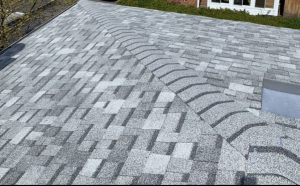As the chilly winter winds give way to the fresh breezes of spring, it’s time to think about more than just your garden. Your roof needs attention too. The upcoming spring showers can bring significant challenges to your home, but with proper preparation, you can ensure your roof stays sturdy and reliable throughout the season.
In this guide, we’ll cover everything you need to know to get your roof ready for the rain, from simple inspections to more advanced roof repairs, keeping your home protected while saving you from costly repairs down the line.
Why Preparing Your Roof for Spring Rain Matters
When the spring rains start, it’s not just about keeping dry—it’s about safeguarding your home. Over the winter, your roof may have experienced damage from snow, ice, or freezing temperatures, which can lead to leaks and structural problems. Without proper preparation, you could face issues like water seepage, mold, and costly repairs.
Investing in roof preparation now will save you from bigger problems later, ensuring your home remains safe and dry.
The Hidden Dangers of Neglecting Roof Prep
Neglecting roof maintenance can lead to serious consequences. Small issues like cracked shingles or clogged gutters may seem minor, but if left unchecked, they can turn into major problems when the rains hit. Leaks can seep into your walls and ceilings, causing mold and structural instability. In extreme cases, prolonged neglect can even lead to a roof collapse, which would require expensive repairs or a full replacement. Ensuring your roof is ready for spring is an investment in the long-term health of your home.
Understanding How Spring Rain Affects Your Roof
Roof Materials and Their Vulnerabilities
Not all roofs are created equal, and different materials face different challenges during the spring months. Here’s a look at how common roofing materials can be affected by the rain:
- Metal Roofs: Increased moisture can lead to rust and corrosion over time.
- Asphalt Roofs: Heavy rain can cause granule loss, leading to faster aging and reduced durability.
- Tile Roofs: Excessive moisture can cause cracking.
- Wood Roofs: Wet conditions may lead to rotting or warping.
Understanding your roof type’s specific needs will guide you in taking the right steps for proper maintenance and preparation.
The Risks of Post-Winter Roof Damage
Spring showers can exacerbate any pre-existing damage to your roof. Whether it’s from cracked tiles, loose shingles, or other small issues, water infiltration can worsen these problems quickly. Over time, neglecting to fix these issues could result in mold, water damage, and structural instability, which can end up costing you thousands in repairs.
Conducting a Thorough Roof Inspection
How to Perform a Roof Inspection
The first step in preparing your roof for the rain is performing a thorough inspection. You can start by visually inspecting your roof for any obvious damage. Look for missing shingles, cracks in flashing, or any signs of moss or algae growth. This can be done from the ground using binoculars, or you can hire a professional to get a more detailed look.
Key Areas to Inspect:
- Gutters and Downspouts: Make sure they’re clear of debris so water can flow freely.
- Chimneys and Vents: Check for cracks or gaps that could let water in.
- Shingles: Look for signs of damage like curling, buckling, or missing shingles.
By catching these issues early, you can prevent more serious damage that could arise from water exposure during the spring showers.
Signs of Hidden Damage
Some roof damage isn’t immediately visible. Look for water stains on ceilings or walls inside your home, or areas on your roof that appear to sag or bulge. These are signs that moisture may already be leaking through, potentially causing significant damage. Address these issues right away to avoid worsening the situation.
Roof Cleaning and Regular Maintenance
The Importance of Roof Cleaning
Regular roof cleaning is essential for maintaining your roof’s lifespan. Over time, debris, moss, and algae can accumulate on your roof, leading to water retention and accelerated damage. Keeping your roof clean will help prevent issues like leaks and rot.
Roof Cleaning Tips:
- Use a soft-bristle broom or leaf blower to remove loose debris.
- Clean moss and algae with a bleach-and-water solution.
- Avoid using high-pressure washers, as they can damage roofing materials.
Hiring a professional for cleaning ensures that your roof is handled safely and effectively, reducing the risk of damage.
Routine Maintenance Tasks
Aside from cleaning, regular maintenance is also essential. These tasks include:
- Clearing gutters and downspouts of leaves and debris.
- Replacing damaged or missing shingles.
- Sealing cracks and holes in your roof.
- Trimming overhanging tree branches that may damage your roof during storms.
By staying on top of these tasks, you can avoid many common roof issues and keep your roof in optimal condition.
Repairing Roof Damage Before the Rain
Common Roof Repairs to Tackle
If you’ve spotted damage during your inspection, it’s time to make repairs. The most common repairs include:
- Fixing leaks: Address any leaks promptly to prevent further damage.
- Replacing missing or damaged shingles: Replace these to prevent water exposure to the underlying roofing materials.
- Repairing cracked flashing: Cracked flashing can lead to leaks and water damage, so it’s essential to address these as soon as possible.
Should You DIY or Hire a Professional?
While small repairs may seem manageable as a DIY project, some roof issues are better handled by professionals. If you’re unsure about the complexity of the repair, or if you don’t feel comfortable working on your roof, it’s best to hire a professional. Roofing contractors have the tools and expertise to handle repairs safely and effectively.
Safety Considerations: If you do choose to tackle repairs yourself, always use proper safety gear, including a sturdy ladder, safety harness, and non-slip shoes. Never attempt repairs during bad weather.
Preventive Measures for Spring Showers
Gutter Guards and Their Benefits
One of the most effective preventive measures you can take is installing gutter guards. These devices prevent leaves, twigs, and other debris from clogging your gutters, ensuring water flows freely and reducing the risk of water damage to your roof.
Trimming Overhanging Tree Branches
Overhanging branches can pose a risk during spring storms. Strong winds or rain can cause branches to snap and fall onto your roof, leading to significant damage. Regular trimming will help prevent this.
Water Repellents and Sealants
Consider applying water repellents or sealants to your roof to provide an additional layer of protection against water penetration. These products can be particularly useful in areas prone to heavy spring rain.
Regular Roof Inspections
Lastly, regular inspections are key to catching issues early before they become major problems. While a DIY inspection is useful, it’s always a good idea to have a professional roofer assess your roof at least once a year. A trained eye can spot potential issues that you may miss.
When to Hire a Professional Roofing Contractor
While DIY roof maintenance can be effective, some situations require professional expertise. If you’re dealing with extensive damage, persistent leaks, or other major issues, it’s time to call in the pros.
Benefits of Hiring a Professional
Professional roofers bring several benefits, including:
- Expertise and Tools: They have the knowledge and equipment to handle complex repairs.
- Safety: Roofing is risky work, and professionals are trained to work safely at height.
- Quality and Warranty: Professionals offer warranties on their work, ensuring long-term peace of mind.
Choosing the Right Roofing Contractor
When hiring a roofing contractor, make sure they are licensed and insured. Look for companies with positive reviews, and always get multiple estimates to ensure you’re getting a fair deal.
Protect Your Home with Integrity Remodeling Roofing and Siding
At Integrity Remodeling Roofing and Siding, we understand the importance of a well-maintained roof, especially during the spring months. As a trusted roofing contractor in Long Beach, NY, we specialize in ensuring your roof stays in top shape, protecting your home from the elements.
Whether you need a thorough inspection, repairs, or a full roof replacement, we’re here to help. Contact us today to ensure your roof is ready for the spring showers.
FAQs
Q: How often should I inspect my roof? Regular roof inspections should be conducted at least once a year, and after major storms. This helps spot early signs of damage.
Q: Can I clean my roof myself? Yes, but take care to avoid using high-pressure washers, as they can damage shingles. If in doubt, consider hiring a professional for a thorough cleaning.
Q: How can I prevent roof leaks during the spring? Regularly inspect and repair damaged shingles, ensure gutters are clear, and apply sealants to prevent water penetration.
Taking the right steps now to prepare your roof for spring rain will save you from future headaches and costly repairs. If you’re unsure about any part of the process, contact Integrity Remodeling Roofing and Siding to ensure your roof is ready to weather the storm.
Name, Address and Phone
Integrity Remodeling Roofing and Siding
564 E Hudson St, Long Beach, NY 11561
516-373-0095





